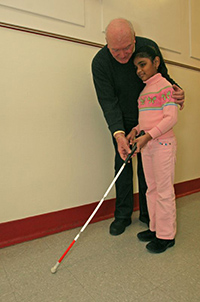Orientation and Mobility for Grade Schoolers
What Is Orientation and Mobility?
Orientation and Mobility (O&M) is the teaching of concepts, skills, and techniques needed to orient to surroundings and to move independently and safely in the environment. To learn and master these skills, a child who is blind or has low vision commonly works with an O&M specialist upon diagnosis through late adolescence. Your child may choose to work with an O&M specialist again as an adult to learn complex routes around a college campus, unfamiliar town, or new workplace.

O&M entails learning to utilize sensory information to orient to the environment; improve knowledge of spatial, body, and environmental concepts; master sighted guide; enhance long-cane techniques; improve the ability to follow directions, execute routes, use cardinal directions, elicit/decline help; travel independently within the school; cross streets under supervision; develop travel skills in neighborhood and community settings; develop skills for traveling in adverse weather conditions; and construct and use maps.
How Do O&M Specialists Approach Instruction?
O&M instruction for grade schoolers includes informal concept development with formal instruction in O&M techniques and skills. Lessons should be assessment-based, motivating, relevant, individualized, and age-appropriate. Each lesson should begin with describing what the child will learn and why the concept, skill, or technique is important.
Opportunities to Explore
- environmental concepts such as road signs, traffic lights, intersections, city blocks, curb cuts, grid patterns, shorelines, buses, taxis, and maps of simple routes;
- mobility tools such as elevators, escalators, people-movers, truncators (bumps on sidewalks indicating intersections), and pedestrian push-to-walk buttons; and
- a variety of travel environments, both indoor and outdoor.
Cane Techniques
The specialist will model specific cane techniques, including:
- traveling across an open room,
- trailing a wall,
- navigating obstacles,
- turning,
- negotiating stairs,
- room familiarization,
- traveling routes (“I,” “L,” and “U” routes), and
- crossing streets (initially with no traffic).
Each technique will be broken down into small, achievable steps. The child will practice a particular skill routine repeatedly until effortless and automatic.
Orientation and mobility skills and techniques will be taught in familiar, controlled environments until mastery; thereafter, they will be rehearsed in unfamiliar, uncontrolled, and busier environments.
As lessons progress and the child masters techniques of indoor and then outdoor travel, the responsibility of orienting to environments falls increasingly on the child.
How Can You Support O&M Instruction at Home?
Family members are integral to the child’s mastery of orientation and mobility.
- Continue to expose your child to a variety of environments and objects, encouraging exploration as you relate unfamiliar environments or objects to familiar ones. Additionally, explain “background” noises, sights, and scents, yet direct attention to useful sensory information.
- Encourage enhancement of hand and body strength. Motivate your child to run with a guide, jump on a trampoline, utilize playground equipment, bicycle, climb rock walls, play sports, play musical instruments, etc.
- Coach your child through problem-solving and give your child time and space to work through challenges before “rescuing.”
- Give your child opportunities to request help.
- An orientation and mobility specialist will teach each mobility and cane technique, though family members should observe lessons and ask the specialist how the skills can be reinforced at home.
- Expect your child to use low-vision devices to obtain information from new environments.
- Ask your child to teach sighted guide to friends and relatives.
- Maintain high expectations of your child’s travel routines.
- Use a GPS in the car, which gives your child feedback about the direction the car is traveling as well as street names.
- Use cardinal directions as you discuss travel and plan routes.
- Talk about the sun’s position and how you can often use the sun to figure out the direction you are traveling.
- Talk about how far you’re traveling by foot and car and how long you anticipate each trip. Discuss feet, miles, and city blocks.